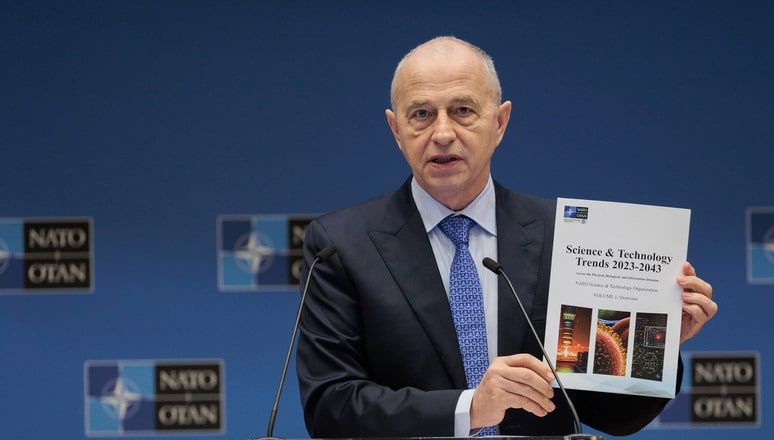Will DIANA—NATO’s DARPA-style innovation hub—improve or degrade global stability?
By Marina Favaro, Ulrich Kühn, Neil C. Renic | March 23, 2023
 Deputy Secretary General Mircea Geoană emphasized responsible use of emerging military technologies during the launch of the NATO Science and Technology Organisation’s 2023-2043 Trends Report in Brussels on Wednesday. Photo credit: NATO news release
Deputy Secretary General Mircea Geoană emphasized responsible use of emerging military technologies during the launch of the NATO Science and Technology Organisation’s 2023-2043 Trends Report in Brussels on Wednesday. Photo credit: NATO news release
The return of major war to Europe has intensified interest in the role of emerging technologies on the battlefield. The deployment of new and evolving weaponry by both Russia and Ukraine provides critical lessons for scholars and policymakers on the importance of military innovation and the dangers of falling behind. In April 2022, against this backdrop, NATO announced the Defence Innovation Accelerator for the North Atlantic (DIANA). DIANA will support the development of a range of emerging technologies—including artificial intelligence (AI), quantum computing, biotechnology, and hypersonic weapons systems—in an effort to strengthen the Alliance’s technological edge. Whether DIANA can deliver on these promises, given the high cost of innovation, remains to be seen. More worryingly, the effort itself—if not conducted responsibly—may negatively impact international stability and human security.
The creation of DIANA was motivated partly by a growing need to burden-share. The rising costs of innovation highlights the importance of high-level collaboration between states in relation to the development of new technologies. Whether these steep costs can be met, however, remains unclear.
DIANA was designed to help NATO work more closely with industry and academia. This transatlantic initiative plans to support start-ups through twinned accelerator networks, offer the use of “deep tech” test centres to assess technological solutions to military problems, develop a virtual marketplace to connect start-ups with trusted investors, and create a rapid acquisition service to translate innovation into military capabilities. Its European regional office will be jointly hosted by the United Kingdom and Estonia, and Canada is bidding to host the North American regional offices.
Comparisons have already been drawn between DIANA and the US Defense Department’s Defense Advanced Research Projects Agency (DARPA). DARPA is responsible for the development of emerging technologies for use by the US military. What distinguishes DIANA from DARPA, however, is scale. DIANA will be financed by all allies via NATO common funding. At present, there is no information publicly available on what proportion of that funding will be allocated to DIANA, but whereas NATO’s annual budget for 2022 was approximately €2.5 billion (about $2.7 billion), the DARPA budget that same year was $3.8 billion US Dollars. It is safe to assume that DIANA will have a fraction of DARPA’s budget, making prioritization of relatively limited resources critical.
Beyond budgetary matters, however, there are deeper questions regarding the intended and unintended implications of this drive for technological innovation. In an age of intensifying great power competition, is the development and use of these emerging technologies more likely to safeguard or undermine international stability and human security?
Our recent study forecasted the potential future impact of 12 emerging technologies on international stability and human security from now to 2040. Surveyed experts anticipated that the effects of these technologies would be overwhelmingly negative. Anti-satellite (ASAT) capabilities (including cyberattacks and satellite jamming/spoofing) and artificial intelligence (AI) for information operations (i.e., next-generation synthetic media and countermeasures) were identified as particularly negative, with few anticipated benefits for stability and security.
Regarding ASAT capabilities, destabilizing effects include the denial or disruption of satellites that play roles in intelligence, surveillance, and reconnaissance; nuclear command, control, and communication; and orbital early warning systems. Interfering with satellites in any of these realms has the potential to create or worsen international crisis instability. Experts also noted the possibility that AI-enhanced information operations—for example, “deep fake” videos that portray national leaders making false statements—will be used to degrade the quality of human decision-making, also to the detriment of crisis stability.
It’s important to emphasize that not all technologies are anticipated to have exclusively negative effects on international stability and security. According to experts, advances in AI and quantum computing could at least potentially improve command, control, communications, computers, intelligence, surveillance, and reconnaissance (C4ISR), as well as increase confidence in arms control by strengthening verification measures. Potential improvements to the information landscape were also cited, though experts warned against an overreliance on AI-produced and sorted information, given the possibility of errors, biases, and safety/security failures in the systems themselves.
Beyond these anticipated effects, our study also found that a technology arms race among the United States, China, and Russia is already underway. According to the experts, the three states are on track to bring all 12 technologies to maturity by 2040. Experts further cautioned that a Russo-Chinese alignment might create new deterrence challenges for the United States and NATO. Such a competitive environment does not bode well for international arms control aimed at mitigating the risks of emerging technologies, nor is it likely to strengthen efforts to salvage nuclear arms control and non-proliferation regimes such as New START or the Non-Proliferation Treaty.
Our research findings have implications for how to navigate the value and risks of initiatives like DIANA. NATO’s pursuit of technological dominance must not be limited to questions of achievability but must also consider moral and strategic implications. While emerging technologies might bolster NATO’s deterrence mission, these capabilities will have varying and oftentimes negative effects on international stability and human security. If not properly mitigated, these effects could undermine NATO’s strategic objectives and its political standing as a responsible international actor.
Initiatives such as DIANA reflect the growing realization among NATO members that more needs to be done to compete in the rapidly changing landscape of emerging technologies. Difficult choices lay ahead regarding prioritization. These choices are made more difficult by the rising cost of military innovation and budgetary pressures at the national level. But amid these financial debates, we cannot lose sight of the moral and strategic dimensions of this issue. Some of these technologies have the potential to significantly undermine international peace and security, particularly if pursued and deployed uncritically. Going forward, time and resources should be devoted not just to innovations in weaponry, but also to measures—including arms control—aimed at mitigating their destructive potential.
Together, we make the world safer.
The Bulletin elevates expert voices above the noise. But as an independent nonprofit organization, our operations depend on the support of readers like you. Help us continue to deliver quality journalism that holds leaders accountable. Your support of our work at any level is important. In return, we promise our coverage will be understandable, influential, vigilant, solution-oriented, and fair-minded. Together we can make a difference.
















